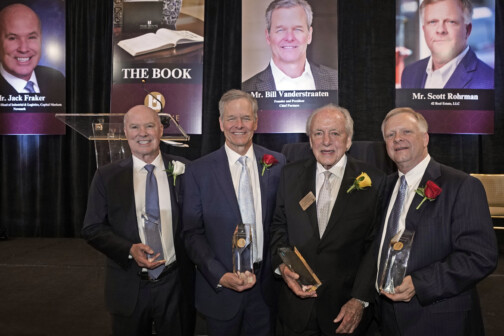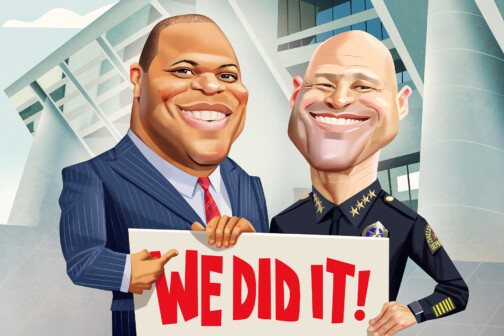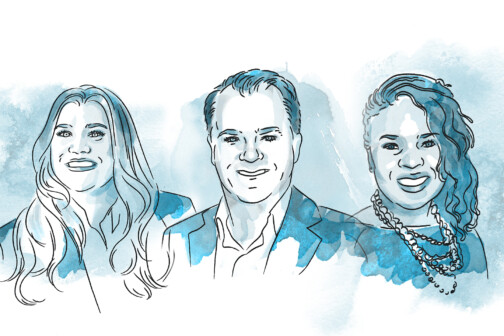 |
| STATION AGENT: First Broadcasting’s Gary Lawrence increases radio towers’ power. |
Pop musician Elvis Costello called it a “sound salvation.” The line from his 1978 hit “Radio, Radio” was a sarcastic bite against the gargantuan industry, and if he were to tell you nearly 30 years later that radio was a sound investment, his tongue would still rest firmly against cheek.
The landscape of terrestrial radio, your everyday AM and FM stations, is hard to truly account for, what with all of the red flags planted into it. Many of the nation’s largest operators, from Clear Channel to CBS, are openly placing affiliates on the auction block. Formats in the biggest markets change on a near-quarterly basis. Even shining opportunities for growth have been proven otherwise; in Dallas, one of the fastest-growing Latin markets, Clear Channel station 97.1 switched to a “regional Mexican” format in late 2005 and immediately leapt into second place.
Only six months later, the station fell back to 18th in local Arbitron ratings.
Sure, terrestrial radio hasn’t gone the way of the 8-track cassette. There’s still plenty of clatter and racket fetching captive ears and advertising dollars. But the likes of satellite services, MP3 players, and burgeoning webcasts have undoubtedly limited the industry’s growth potential. Right?
“You’ve just defined opportunity,” Gary Lawrence says. The 50-year-old longtime Dallasite is CEO of First Broadcasting Investment Partners, an investment company that specializes in media investing, the bulk of which is terrestrial radio. Or maybe “obsesses” is a better way to put it. Down the hall from Lawrence, past the full team of media investment gurus, is an engineering department and construction team designing new broadcast technologies. One door down, a screen-filled “war room” analyzes airwave maps at all hours. And just across the hall from the receptionist, next to banners for local oldies and country radio stations, a DJ sits in one of the downtown Dallas office’s recording booths.
| ›› THE TAKEAWAY |
|
1. Where some see problems, others see opportunity.
2. Strategy is good, but you need relationships to implement it. 3. It takes money to make money. |
Lawrence may be countering the obvious evidence when he gloats about the state of the radio industry. But with so much of his own evidence in-house, can you blame him?
“Simply put, we consider ourselves to be technologically innovative media investors.” That one sentence is as close as Lawrence gets to explaining his job without requiring an operator’s manual to understand him. There’s something almost militaristic in his demeanor—rigid posture, hair and moustache as thick and jet-black as his suit, little second-guessing of his words—and he constantly catches himself in hardcore radio mode, rattling off technical terms like one of his company’s engineers.
At the same time, his moustache crowns a consistent smile on a face that doesn’t look a day over 40, and he has a propensity to whistle for no good reason. His casualness is disarming, almost masking the fact that the man has been doing business around Dallas for 25 years, but he’s back in business character when trying to describe the multi-tiered operations of First Broadcasting.
Through the jargon emerges a series of steps for a typical First Broadcasting investment, a process that comes off like a very high-tech game of “We Buy Ugly Houses.” Engineers start by finding candidate stations and towers across the country that have potential to be “enhanced,” be it by re-engineering the tower or by making negotiations with other stations (more on that later). The investment team then sets out to form a joint venture or buy the target station outright—“We want to control all aspects of our investments,” Lawrence says—and make any necessary repairs, upgrades, and negotiations. The end result is a stronger radio signal or one that can reach many more listeners than before, which means the signal can be sold off at a much higher value (though any acquired stations are run in-house in the interim if needed).
 |
| Source: National Association of Broadcasters, M Street Corporation |
It’s in the war room that First Broadcasting analyzes stations day after day. The room resembles any military base scene in a movie—screens cover the walls, and terminals examine data-splattered computer maps. But these systems are on the hunt for something arguably more scattershot than a terrorist cell. They’re looking for radio waves.
“Spectrum allocation in the United States is very inefficient, as you might imagine with something that grew up 100 years without a really clear architecture or blueprint,” Lawrence says. “[We try] to make sure the spectrum is being used as efficiently as possible to create the most radio for everybody. That’s just not the way it was thought about in the 1920s.”
Lawrence grabs a marker and draws three overlapping circles like a Venn diagram, each representing a separate radio station’s reach in a hypothetical metropolitan area. “Most [station] owners will say, ‘I’m doing the best job I can with my signal.’ What they’re unable to do, because they don’t have the proprietary technology software, hardware, and know-how that we’ve developed over the last 15 years, is to analyze the entire market.”
He hypothesizes from the perspective of circle A, the station he wants to acquire in the west side of the grid. What if the tower in circle B physically moved further to the north? What if circle C’s position on the dial moved from, say, 96.1 to 102.3? Lawrence grabs his eraser, and with reduced overlap, circle A grows and their signal is optimized.
 |
First Broadcasting runs thousands of these hypothetical tests with its systems until the staff finds the perfect combination of terrain, signal enhancements, and third-party moves, all within FCC guidelines. “This is where we really make our money,” Lawrence says. “We can come back and say, ‘If those two stations will do this and this, you can cover three times as much of the population as you used to.’”
But for all the hubbub Lawrence raises over this “mathematically intensive series of multi-variable analyses,” he ultimately relies on not only computers but as much on diplomacy—getting the B and C circles of the world to agree.
“I’ve found over the years that the key to success in business, and indeed, personal relationships, is to never ask people to do something that isn’t in their own self-interest,” Lawrence says.
Though he’s occasionally able to work out a win-win tower move, economic incentives—cash payments and equipment upgrades—are crucial to First Broadcasting’s business model, which has run in its current state since 1998. Six years prior, the company was founded to acquire two radio stations in the San Francisco area, but in the years afterward, this “buy, improve, and sell” investment model—backed by in-house research and optimization—proved lucrative enough to become the company’s main focus. The main focus for now, that is.
In the ideal scenario, the radio signal maneuverings are actually a win-win-win: a win for the station, a win for First Broadcasting, and a win for the radio-listening community. But on rare occasions, the three-legged stool of success breaks down.
 |
| RAH, RAH RADIO: Lawrence sees promise, not problems, in the current state of terrestrial radio. |
Lawrence recalls a scenario in which a deal greatly expanded a signal’s reach at the expense of the listeners. The reconfiguring left a nearby town completely unable to hear its favorite station. Basically, in re-Venn-diagramming for a deal a few years ago, one town was lost so other towns could be reached.
First Broadcasting fixed what they feared they’d broken. For one thing, they built a new station to repay that city for the inconvenience. “It was just responsible corporate citizenship,” Lawrence says. They also bought a few hundred radios.
“We came up with something really creative. Have you heard of the subcarrier band? Our regular radios don’t pick ’em up, but you can get a subcarrier band radio. We ended up buying a boatload of subcarrier radios and setting up a community radio station—it’s a tiny community in the mountains of central California—so we provided a way for them to have their local station.”
But such a snafu is a rare occurrence for the company that has pulled off deals in more than a dozen states in its 15 years of operation. Even after so many years, Lawrence says he’s yet to see any similar media investment firms take on the radio landscape the way First Broadcasting has, pointing to two key barriers to entry that his company has overcome: technical know-how and cold, hard capital.
“This is 100 percent equity,” Lawrence says. “A typical project for us will involve millions of dollars of expenditure, and at any given time, we’ll have as many as 20 projects in process. That’s the kind of capital you have to bring and be able to risk—not be able to leverage it—on the deals.” And in assessing risks, it doesn’t hurt to have engineers developing signal tweaks and manning a war room.
Such a unique position in the market could prove futile if radio’s an investment dinosaur, but again Lawrence doesn’t see it that way.
“I’m not intimidated by the current cooling off in terrestrial radio at all. In fact, we fully expected it.” He points to the FCC Telecom Act of 1996 which allowed single corporations to suddenly own many more radio stations. “Having lived through a number of cycles, you know what happens then: a land rush.”
Lawrence has been around business in Dallas long enough to be patient through such cycles. Before joining First Broadcasting’s board of directors in the late ’90s, he headed the technology transactions group at Dallas law firm Akin, Gump, Strauss, Hauer & Feld, LLP, and in discussing his years in North Texas, Lawrence name-drops old friend and local real estate developer Craig Hall, who he says taught him that “there’s an attractiveness to down markets.”
From 2002 on, Lawrence served as president and vice chairman of First Broadcasting until he became CEO in January, after company founder Ronald Unkefer stepped down to focus on his charity organization, the Unkefer Family Foundation. “Both of us expected this would happen over time,” Lawrence says, “but I probably wouldn’t have expected it to happen as soon as it did.”
this may very well prove a busy first year for the new ceo. last November, the company worked in tandem with the FCC to drop processing times for the company’s typical purchase, move, and joint venture operations; Lawrence says time has been cut “from as long as three years to around six to nine months” on an average deal for one station, opening up First Broadcasting’s efforts to more impatient joint venture partners. As he stated earlier, the land rush of the late ’90s has resulted in the great sell-off of today, and First Broadcasting will make the most out of new, undervalued signals through its usual optimization process.
Even bigger, Lawrence aspires to expand his company’s spectral analysis know-how into the next logical level of radio waves: TV signals.
“One of the secrets about TV is that there are still a large number of over-the-air TV consumers, guys who don’t have cable to their house or satellite,” Lawrence says. “In a market like Dallas, that’s almost half of the market. Pretty amazing statistic. In the case of those guys, everything we do with radio signals is applicable in the TV arena. [We’ll] find ways to help make more and better television for people just like we’ve done for radio. Especially for that segment of the population, which often is a largely ethnic population, that is taking its signals over the air, to improve signals for them.”
That new direction may not come until Q4 of this year, if not later, but in spite of an uneven, unpredictable radio landscape, Lawrence is happy to assert that his company is possibly too busy with radio deals to rush into the next phase of First Broadcasting. Nothing seems to stop this man from whistling his happy, radio-lovin’ tune.
“Maybe 10 years from now, I’ll look back at this conversation and say how foolish I was, but I’m not concerned about that at all,” Lawrence says. “Terrestrial radio is a permanent part of the landscape. The downturn has actually created more investment opportunities for us. Today, in a given month, we review three times as many opportunities as we would have three years ago. That’s a function of the fact that our technology’s better, the market is more open to transactions today, and most of all, nobody speaks with the voice of the community as much as terrestrial radio.”
Adjust That Dial
How First Broadcasting strengthens signals and makes money.
 |
THE BEFORE: In the illustration (right), Station A is the targeted tower. First Broadcasting’s goal would be to make its signal stronger and therefore worth more money when it’s sold. How? Stations B and C have a lot to do with it. If B physically relocates to the north, that decreases crossover in the northern part of A’s circle, a move that’ll almost certainly require First Broadcasting to kick in economic incentives to tower B. And if C moves its location on the dial from, say, 96.1 to 102.3, A and C reduce each other’s crossover—a deal that’s beneficial to both by default, therefore requiring less in economic incentives that First Broadcasting has to pay.
THE AFTER: Notice a larger circumference for circle A, thanks to engineering and construction tweaks from First Broadcasting. But also notice a circle B that overlaps less and a circle C that overlaps with a less dark color, meaning that the signals coexist more efficiently. Win-win-win.
 |





